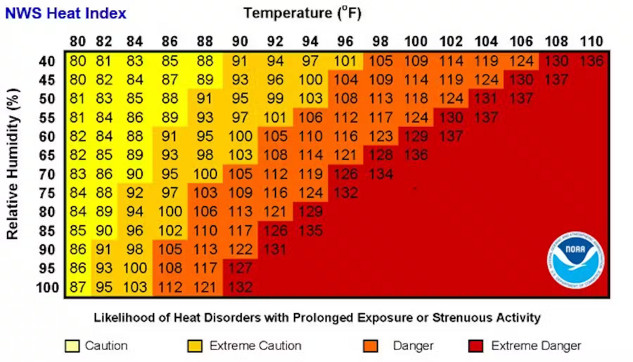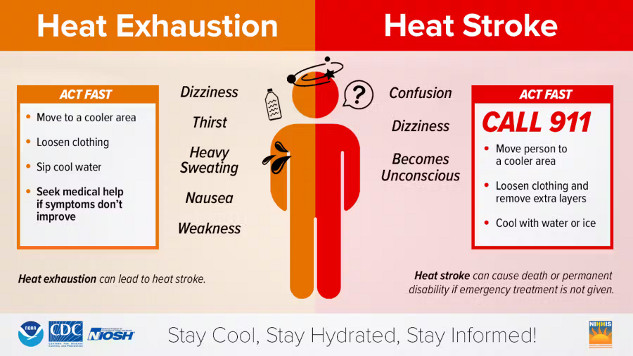
The sticky combination of heat and high humidity can be more than uncomfortable – it can be deadly. Mario Tama / Getty Images
You’ve probably heard people say, “It’s not the heat, it’s the humidity.” There’s a lot of truth to that phrase, and it’s important to understand it as summer temperatures rise.
Humidity doesn’t just make you feel sticky and uncomfortable – it also creates extra dangerous conditions on hot days. Together, too much heat and humidity can make you sick. And in severe cases, it can cause your body to shut down.
Meteorologists talk about the risk of heat and humidity using the heat index, but it can be confusing.
I’m a risk communication researcher. Here’s what you need to know about the heat index and some better ways meteorologists can talk about the risks of extreme heat.
What is the heat index, and how is it measured?
Heat index is the combination of the actual air temperature and kelembapan relatif:
-
Air temperature is how hot or cold the air is, which depends on factors such as the time of day, season of the year and local weather conditions. It is what your thermometer reads in degrees Celsius or Fahrenheit.
-
Relative humidity compares how much water vapor is in the air with how much water vapor the air could hold at that temperature. It’s expressed as a percentage.
The heat index tells you what it “feels like” outside when you factor in the humidity. For example, if it’s 98 degrees Fahrenheit (36.7 Celsius) with 55% relative humidity, it might feel more like a scorching 117 F (47.2 C).

NOAA’s heat index chart shows how heat and humidity combine for dangerous temperatures. NOAA
But there’s a catch: Heat index is measured in shady conditions to prevent the sun’s angle from affecting its calculation. This means if you’re in direct sunlight, it will feel even hotter.
Apparent temperature, alerts and wet bulb
“Apparent temperature” is another term you might hear this summer.
Apparent temperature is the “feels like” temperature. It considers not only temperature and humidity but also wind speed. This means it can tell us both the heat index and wind chill – or the combination of the temperature and wind speed. When conditions are humid, it feels hotter, and when it’s windy, it feels colder.
We found that apparent temperature is even less well understood than the heat index, possibly due to the word apparent having various interpretations.
There are a few other ways you may hear meteorologists talk about heat.
Suhu glob mentol basah considers temperature, humidity, wind and sunlight. It’s especially useful for those who spend time outdoors, such as workers and athletes, because it reflects conditions in direct sunlight.
Risiko Haba is a new tool developed by the National Weather Service that uses colors and numbers to indicate heat risks for various groups. More research is needed, however, to know whether this type of information helps people make decisions.
In many places, the National Weather Service also issues alerts such as excessive heat watches, warnings and advisories.
The risk is getting lost in translation
Knowing about heat and humidity is important, but my colleagues and I have found that the term heat index is not well understood.
We recently conducted 16 focus groups across the United States, including areas with dry heat, like Phoenix, and more humid areas, like Houston. Many of the people involved didn’t know what the heat index was. Some confused it with the actual air temperature. Most also didn’t understand what the alerts meant, how serious they were or when they should protect themselves.
In our discussions with these groups, we found that meteorologists could get across the risk more clearly if, instead of using terms like heat index, they focus on explaining what it feels like outside and why those conditions are dangerous.
Watches, warnings and advisories could be improved by telling people what temperatures to expect, when and steps they can take to stay safe.
Climate change is exacerbating heat risks by making extreme heat more common, intense and long-lasting. This means clear communication is necessary to help people understand their risk and how they can protect themselves.
Apa yang anda boleh lakukan untuk melindungi diri anda
With both hot and humid conditions, extra precautions are necessary to protect your health. When you get hot, you sweat. When sweat evaporates, this helps the body cool down. But humidity prevents the sweat from evaporating. If sweat cannot evaporate, the body has trouble lowering or regulating its temperature.
Although everyone is at risk of health issues in high heat, people over 65, pregnant women, infants and young children can have trouble cooling their bodies down or may run a higher risk of becoming dehydrated. Certain health conditions or medications can also increase a person’s risk of heat-related illness, so it’s important to talk to your doctor about your risk.
Heat illnesses, such as heat exhaustion and heat stroke, are preventable if you take the right steps. The U.S. Centers for Disease Control and Prevention focuses on staying cool, hydrated and informed.
-
Stay cool: Use air conditioning in your home, or spend time in air-conditioned spaces, such as a shopping mall or public library. Limit or reschedule your exercise and other outdoor plans that occur in the middle of the day when it is hottest.
-
Stay hydrated: Drink more water than you might otherwise, even if you don’t feel thirsty, so your body can regulate its temperature by sweating. But avoid sugary drinks, caffeine or drinks with alcohol, because these can cause you to become dehydrated.
-
Stay informed: Know the signs of heat illness and symptoms that can occur, such as dizziness, weakness, thirst, heavy sweating and nausea. Know what to do and when to get help, because heat illnesses can be deadly.


The difference between heat exhaustion and heat stroke and the CDC’s advice on how to respond. NOAA, CDC
Micki Olson, Senior Researcher in Emergency and Risk Communication, Universiti di Albany, Universiti Negeri New York
Artikel ini diterbitkan semula daripada Perbualan di bawah lesen Creative Commons. Membaca artikel asal.
Buku berkaitan:
Badan Mengekalkan Skor: Otak Minda dan Badan dalam Penyembuhan Trauma
oleh Bessel van der Kolk
Buku ini meneroka hubungan antara trauma dan kesihatan fizikal dan mental, menawarkan pandangan dan strategi untuk penyembuhan dan pemulihan.
Klik untuk maklumat lanjut atau untuk memesan
Nafas: Sains Baharu Seni yang Hilang
oleh James Nestor
Buku ini meneroka sains dan amalan pernafasan, menawarkan pandangan dan teknik untuk meningkatkan kesihatan fizikal dan mental.
Klik untuk maklumat lanjut atau untuk memesan
The Plant Paradox: Bahaya Tersembunyi dalam Makanan "Sihat" Yang Menyebabkan Penyakit dan Berat Badan
oleh Steven R. Gundry
Buku ini meneroka kaitan antara diet, kesihatan dan penyakit, menawarkan pandangan dan strategi untuk meningkatkan kesihatan dan kesejahteraan keseluruhan.
Klik untuk maklumat lanjut atau untuk memesan
Kod Kekebalan: Paradigma Baharu untuk Kesihatan Sebenar dan Anti-Penuaan Radikal
oleh Joel Greene
Buku ini menawarkan perspektif baharu tentang kesihatan dan imuniti, menggunakan prinsip epigenetik dan menawarkan pandangan serta strategi untuk mengoptimumkan kesihatan dan penuaan.
Klik untuk maklumat lanjut atau untuk memesan
Panduan Lengkap Puasa: Sembuhkan Tubuh Anda Melalui Puasa Selang Selang, Hari Bergantian dan Berpanjangan
oleh Dr. Jason Fung dan Jimmy Moore
Buku ini meneroka sains dan amalan berpuasa yang menawarkan pandangan dan strategi untuk meningkatkan kesihatan dan kesejahteraan keseluruhan.
























